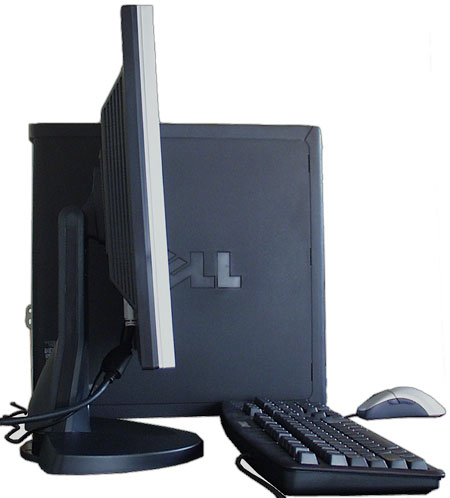For 2003 we ordered a new Dell PrecisionTM Workstation 350 with a 3.06 Ghz P4 CPU and hoped for the best. One of the most attractive aspects of the new P4 is that it supports Hyper-Threading which puts the P4 closer to the Xeon than ever before. Illustrated to the right is a screen capture of the P4's CPU Usage History indicating two readings much like a dual Xeon workstation or server might. The basic concept behind Hyper-Threading is that the CPU can delegate resources to multiple tasks or applications simultaneously much like a dual CPU station can. The catch to this concept is that the applications need to support hyper/multi-threading and few actually do.
In addition to paying a premium for the new P4, we added Dell's 36GB Ultra 320 SCSI, 1 inch (15,000 rpm), and got their 1Gb PC 1066 RDram special. For Video, we opted for the nVidia Quadro4 900XGL, 128Mb ( dual monitor capable ) because its price was within an acceptable range for our budget. By comparing the Sony 18" Flat Panel with Dell's 19" Flat Panel, the price difference of $2000 and $799, respectively, made the decision rather easy and thus we ordered the Dell UltraSharp™ 1900FP 19 inch Flat Panel Monitor (19.0 inch vis).
If you are interested in the full specifications for this workstation, you can download the .pdf file of our order as it was placed with Dell's on-line store. del_Precision_350_p4.PDF.
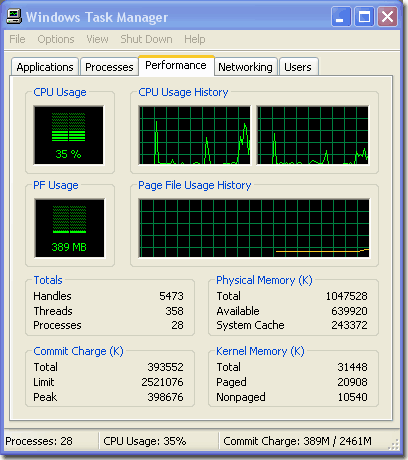
The time from ordering on-line to delivery was about 2 1/2 weeks ( during the Christmas Holidays, no less ) and the first bit of irritation with Dell was that they didn't report shipment of our machine until it had actually been delivered. The delivery guy had actually made an earlier attempt and came back in the afternoon; so it seems that Airborn Express is faster than Dell's e-mail. Upon delivery, the first thing I noticed on one of the boxes, the monitor box, was that it had a nice big label with "Made in Mexico" on it and I had that gut reaction that many Americans had about "Made in Japan" back in the 70's ( remember? ). Anyway, now most of us think Japanese products are of great quality so I figured I would hold any judgments until further inspection of the product. And heck, the whole PC could have been manufactured there as well in one way or another so the real evaluation is in the performance and longevity.
The 19" Flat Panel monitor was the first thing we had to look at so out it popped and up on the closest desk it went for scrutinizing. It had a good solid base with enough weight to prevent it from tipping or vibrating like some of these monitors do. It had an overall acceptable look to it so it was now time to get everything hooked up.
The black Dell keyboard was nice to look at but had a cheap quality to it so that might soon be replaced with a better model. It is usable but the keys have a soft response that many may not like. The Microsoft Intelli-whatever mouse was fine except that they are mostly designed for right-handers and a couple of us like to draw with our left hand so we can type with our right. It gets a little tricky to do that with the ergo-right design.
The Dell PC box is one of those new plastic cases with "easy" access that sometimes proves more difficult to unsnap than the old steel screw models but its black color is attractive and all of the ports and connectors on the back, color coded, are nicely arranged for cable access. The front has a flip up panel that conceals a USB and headphone connector. This panel is actually the worst part of the design because the hinge mechanism is really sloppy and seems cheap. I would rather just see a clean USB and headphone connector directly on the front face - perhaps incorporated in the Dell Logo or something.
As usual and not unique with Dell, many of the cables push the edge of acceptable length and we would love to see a couple of feet added to most of them; especially the monitor, keyboard and mouse.
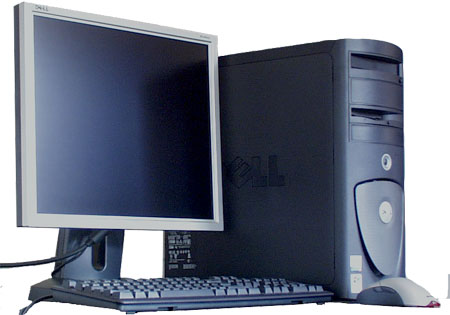
When shopping for Flat Panel monitors, be careful reviewing the specifications so you don't end up with an unexpected surprise. In the case of this flat panel monitor, for example, the size is large enough that a higher resolution is necessary to compensate for oversized icons, text, windows and so forth. This is generally true whenever you get a larger display because the pixels will also appear larger. Flat Panel monitors tend to offer less impressive resolution settings the larger the display so though you might find that 22" Flat Panel monitor an exciting prospect at a great price, you may find the 1280x1024 maximum resolution intolerable. This 19" Dell monitor has a maximum resolution of 1280x1024 and that's the minimum we want to run it at.
This Dell monitor has one really irritating surprise that we did not expect because it was not obvious in any of the pictures or basic specifications: the height is not adjustable. If you look at the slot in the back neck it looks a lot like one designed for height adjustment but it's purely aesthetic. The only thing this monitor offers for adjustment is the pivot rotation. Overall the default height is not so bad but again, this could prove to be a surprise; especially for those who are not average in height or sit at an average height at their desk.
The Precision 350 makes a bit of fan noise but that SCSI hard-drive is the most noticeable noise of all. To be fair, however, I have never come across a quiet SCSI drive so that just seems to be a byproduct of 15,000 rpm.
The monitor was incredibly bright compared to the other monitors we have around and its 500:1 Contrast ratio definitely showed. However, we also noticed some pixel peculiarities along the left side and top that we speculated being the result of a hand or fingers touching it during assembly. These pixel streaks really look like a hand slid over the plastic panel but the effect is only noticeable on a black background under dim lighting ( "Made in Mexico" ? ).
As soon as we got all of that irritating configuration stuff done and Windows XP Professional running, we had to load Architectural Desktop 3.3 and Viz 4 to see what the performance was like.
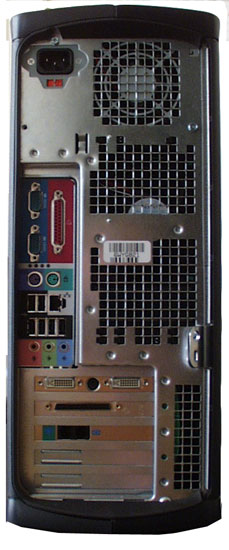
When we got ADT 3.3 installed, we were fairly impressed by the boot time but ADT just can't load fast enough for any of us. When we loaded several of the sample ADT projects, we were a bit disappointed by the load time of the full models and the 3D Shaded Orbiting until we realized that the Orbiting wasn't reverting to wireframe but staying in full shaded mode. The load time was bad but some of those project examples have a lot of crazy objects in them, like dozens of trusses and so on that eat up memory merely because of the number of copies ( just as you can slow any system down with a huge Array of Lines ).
In testing our own projects, we were very impressed and I, for one, started seeing things that I had missed before ( that's what I get for working on my laptop all of the time ). 3D Orbiting Gourad Shaded Views was fantastic and even AutoCAD's bad rendering engine cranked out results in an acceptable manner.
Viz 4 seems to get more out of the hyper-threading feature than ADT and that seems about right given that Viz 4 is multi-threaded. While rendering, you can actually see Viz take full use of the CPU's resources while that does not appear to occur with ADT. In future testing, we'll try rendering without the hyper-threading feature turned on to compare performance times with the feature turned on.
Photoshop 7 snaps along like mad and never shows a sign of hesitation on Filters, Palettes or Layer Effects and has made working with this program a whole new experience. The brightness of the monitor makes the colors feel 3 dimensional when compared to the older flat panel and analog monitors that we have around; it's like putting on sun glasses now when I look at my other monitor. As I understand it, only a few tools in Photoshop 7 are actually multi-threaded so how much improvement a user gets would depend on the tools used.
Illustrated to the right I show what the CPU Usage History looked like when I was messing around with ADT and Viz 4 at the same time. I loaded a 9.5 Mb ADT file and put it into Continuous Orbit, loaded Viz 4, Linked the same file and started orbiting it at the same time. What was interesting to me was that I could easily decipher the resources being use by ADT since the continuous orbit maintained a fairly straight curve. For Viz 4, you can actually see the curve spike as I orbited around. When I rendered this file, both graphs leveled off as a straight line at near 100% so that didn't make much of an interesting screen capture.
ADT 3.3 with the International Extensions and all Productivity Extensions loads in 9 seconds when first fired up.
Viz 4 loaded in 13 seconds when first fired up.
Photoshop 7 loaded in about 5 to 6 seconds when first fired up
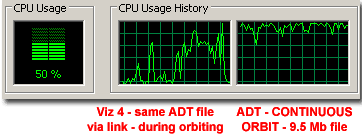
After having worked on this workstation for 4 weeks now, I am rather impressed with the performance and display.
Though the keyboard is a bit cheesy, it hasn't been enough of an irritation that I'll be ordering a new one soon. The only significant drawback to the whole package thus far is that the monitor does have a slight defect ( as discussed above ) and that it did not allow for horizontal adjustment ( only pivoting ). The heat generated by this machine is enough to make my feet really toasty during cooler days but has surprised me on a couple of occasions. One day I left the machine on to run an errand and came back to hear the fans running at full speed. I checked to see what could be causing such an overload and it turned out that Word had crashed somehow. Another odd peculiarity is that I have had to set the clock back twice since setting this machine up. I guess it is just so fast that it moves forward in time
Whether or not the 3.06 Ghz P4 is worth the extra cash and whether or not the hyper-threading feature is actually much of a benefit, ultimately lies with the consumer's perspective on such matters. From what we have done with this system thus far, the difference between the 2.8 Ghz and 3.06 Ghz machine is really rather negligible but that might change as more software begins to support hyper-threading.
In the coming weeks, we will dig in deeper and run more tests with and without the hyper-threading feature enabled.
If you want scientific proof of performance and real testing, there are plenty of articles on the web now from major news and magazine sources such as:
http://www.pcmag.com/article2/0,4149,674214,00.asp
